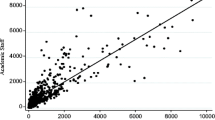Abstract
This paper formulates a model to partition theobserved administrative/faculty ratio (or administrativeintensity) for higher education institutions into twocomponents. One component uses internal factors. The second component acts as an augmenter anduses external factors. In particular, it uses sources offunding dependency to explain additionally the demandfor administrative resources. A logit analysis is used to link the type of institutionalcontrol to sources of funding dependency. The mainresults indicate that public institutions use relativelyless administrative resources compared to privates in seeking public and private sources of funding.Privates, on the other hand, use relatively less whenseeking private funding, but they use relatively morewhen seeking public funding. Policy implications relate to barriers of entry to the fundingsources.
Similar content being viewed by others
REFERENCES
Alchian, Armen A., and Demsetz, Harold (1972). Production, information costs, and economic organization. American Economic Review30(5): 777-795.
Andersen, Kenneth E. (1991). Anatomizing bloat. Academe77(6): 20-24.
Bergmann, Barbara R. (1991). Bloated administration, blighted campuses. Academe77(6): 12-16.
Blau, Peter M. (1994). The Organization of Academic Work, 2nd ed. New Brunswick, NJ: Transaction Publishers.
Bowen, Howard R. (1980). The Cost of Higher Education: How Much Do Colleges and Universities Spend Per Student and How Much Should They Spend? Report issued by the Carnegie Council on Policy Studies in Higher Education. San Francisco: Jossey-Bass.
Brinkman, Paul T. (1981). Factors affecting instructional costs at major research universities. Journal of Higher Education52(3): 265-279.
Brinkman, Paul T. (1990). Higher education cost functions. In Stephen A. Hoenack and Eileen L. Collins (eds.), The Economics of American Universities: Management, Operations, and Fiscal EnvironmentChapter 5, pp. 107-128. Albany, NY: State University of New York Press.
Brinkman, Paul T., and Leslie, Larry L. (1986). Economies of scale in higher education: Sixty years of research. Review of Higher Education10(1): 1-28.
Button, Kenneth J., and Weyman-Jones, Thomas G. (1992). Ownership structure, institutional organization and measured X-efficiency. American Economic Review82(2): 439-445.
Cohn, Elchanan, Rhine, Sherrie L. W., and Santos, Maria C. (1989). Institutions of higher education as multi-product firms: Economies of scale and scope. Review of Economics and Statistics71(2): 284-290.
De Alessi, Louis (1983). Property rights, transaction costs, and X-efficiency. American Economic Review73(1): 64-81.
de Groot, Hans, McMahon, Walter W., and Volkwein, J. Fredericks. (1991). The cost structure of American research universities. Review of Economics and Statistics73(3): 424-431.
Frantz, Roger S. (1988). X-Efficiency: Theory, Evidence and Applications. Boston, MA: Kluwer Academic Publishers.
Frantz, Roger S. (1992). X-efficiency and allocative efficiency: What have we learned? American Economic Review82(2): 434-438.
Gander, James P. (1986). The economics of university-industry research linkages. Technological Forecasting and Social Change29(1): 33-49.
Gander, James P. (1987). University/indu stry research linkages and knowledge transfers: A general equilibrium approach. Technological Forecasting and Social Change31(2): 117-130.
Gander, James P. (1991). Managerial intensity, firm size and growth. Managerial and Decision Economics12(2): 261-266.
Getz, Malcolm, and Siegfried, John J. (1991). Cost inflation. In Charles T. Clotfelter, Ronald G. Ehrenberg, Malcolm Getz, and John J. Siegfried, Economic Challenges in Higher Educationpp. 261-285. Chicago: The University of Chicago Press.
Glass, J. C., McKillop, D. G., and Hyndman, N. (1995). Efficiency in the provision of university teaching and research: An empirical analysis of UK universities. Journal of Applied Econometrics10(1): 61-72.
Grassmuck, Karen (1990). Big increases in academic-support staffs prompt growing concerns on campuses. The Chronicle of Higher Education36(28): A1, A32-A34.
Gumport, Patricia J., and Pusser, Brian (1995). A case of bureaucratic accretion: Context and consequences. Journal of Higher Education66(5): 493-520.
Halfond, Jay A. (1991). How to control administrative cost. Academe77(6): 17-19.
Hanushek, E. A. (1987). Educational production functions. In George Psacharopoulos (ed.), Economics of Education: Research and Studies, pp. 33-41. Oxford: Pergamon Press.
Herfindahl, Orris C. (1950). Concentration in the steel industry. Unpublished Ph.D. dissertation. New York: Columbia University.
Kolluri, Bharat R., and Piette, Michael J. (1985). The determinants of the salaries of chief academic administrators. Atlantic Economic Journal13(2): 61-68.
Leibenstein, Harvey (1966). Allocative efficiency vs. ª X-efficiency.º American Economic Review56(3): 392-415.
Leibenstein, Harvey (1975). Aspects of the X-efficiency theory of the firm. Bell Journal of Economics6(2): 580-606.
Leibenstein, Harvey (1978). On the basic proposition of X-efficiency theory. American Economic Review68(2): 328-332.
Leibenstein, Harvey (1992). Empirical Estimation and partitioning of X-inefficiency: A data-envelopmen t approach. American Economic Review82(2): 428-433.
Leslie, Larry L., and Rhoades, Gary (1995). Rising administrative costs: Seeking explanations. Journal of Higher Education66(2):187-212.
Martin, Stephen (1994). Industrial Economics: Economic Analysis and Public Policy, 2nd ed. New York: Macmillan.
Massy, William F. (1990). A paradigm for research on higher education. In John C. Smart (ed.), Higher Education: Handbook of Theory and Research, pp. 1-34.New York: Agathon Press.
Olson, Jeffery E. (1994). Institutional and technical constraints on faculty gross productivity in American doctoral universities. Research in Higher Education35(5): 549-567.
Olson, Jeffery E. (1997). The cost-effectiveness of American higher education: The United States can afford its colleges and universities. In John C. Smart (ed.), Higher Education: Handbook of Theory and Research, pp. 195-242. New York: Agathon Press.
Pondy, Louis R. (1969). Effects of size, complexity, and ownership on administrative intensity. Administrative Science Quarterly14(1): 47-60.
Stigler, George J. (1976). The X-istence of X-efficiency. American Economic Review66(1): 213-216.
Tolbert, Pamela S. (1985). Institutional environments and resource dependence: Sources of administrative structure in institutions of higher education. Administrative Science Quarterly30(1): 1-13.
Verry, D. W. (1987). University internal efficiency. In George Psacharopoulos (ed.), Economics of Education: Research and Studies, pp. 65-69. Oxford: Pergamon Press.
Volkwein, James F., and Malik, Shaukat M. (1997). State regulation and administrative flexibility at public universities. Research in Higher Education38(1): 17-42.
Zemsky, Robert, and Massy, William F. (1990). Cost containment: Committing to a new economic reality. Change22(6): 16-22.
Zumeta, William (1997). State policy and private higher education: Past, present and future. In John C. Smart (ed.), Higher Education: Handbook of Theory and Research, pp. 43-106. New York: Agathon Press.
Rights and permissions
About this article
Cite this article
Gander, J.P. ADMINISTRATIVE INTENSITY AND INSTITUTIONAL CONTROL IN HIGHER EDUCATION. Research in Higher Education 40, 309–322 (1999). https://doi.org/10.1023/A:1018799016920
Issue Date:
DOI: https://doi.org/10.1023/A:1018799016920




